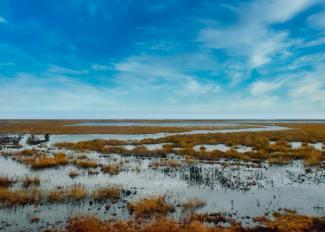If you told me years ago that I would be pursuing a degree in statistics and machine learning, I would not have believed you. Even after receiving the 2021 National Wetlands Award and immersing myself in a vibrant and innovative college environment, I have come to more fully appreciate the many ways we can approach wetlands conservation and education efforts.
Since elementary school, I have been dedicated to sharing my passion and appreciation for wetlands and their flora and fauna. My early efforts researching bioassessment methods, creating and teaching curricula, and writing grants led to the conservation of over 250 acres of wetlands and forest in urban New Jersey.
Eager to continue my ecological research beyond the 12th grade, I began my collegiate academic journey at Carnegie Mellon University as a biology major. I gradually waded into deeper statistical waters, which inspired me to find new ways to gather environmental data—with the goal of increasing accuracy, precision, and statistical power to better observe changes in ecosystem health over time.

I applied these new statistical skills to build models with the bioassessment and chemical data I gathered, creating an interactive, online demonstration to illustrate how environmental stressors, including heavy metals, nutrient pollution, and deforestation, influence the organisms in a freshwater aquatic ecosystem. The interactive demonstration allows the user to toggle environmental parameters such as the amount of shade or the concentration of heavy metals, all conditions that are influenced by human activity. Users can then “travel” to a virtual underwater world reflecting the ecosystem, sample organisms by clicking on them, and return to land where the collected organisms will be used to calculate the biotic index health score, which measures aquatic ecosystem health based on a sample of aquatic macroinvertebrates. The organisms present are a wonderful reflection of cumulative environmental stressors and pollutants over time. Different organisms have adapted to withstand different conditions. For example, non-biting midges in the genus Chironomus are able to withstand low oxygen environments. The healthiest environments will have an abundance of pollution-intolerant organisms as well as high biodiversity. The demonstration is brought to life with simulated fish, which respond to each other. These “fish” are beautiful and vibrant—and created from mathematics I could only dream of years earlier. I have come to appreciate math so much that I am now a teaching assistant for the Statistics Department. I greatly enjoy working with the students and helping them work on statistical analyses and reports. I hope to inspire my students to perform analysis and develop insights with data that is meaningful to them.
Moreover, it is amazing where inspiration and interest might take you. I was accepted into the lab of Professor Terrence J. Collins, the Teresa Heinz Professor in Green Chemistry, and Chemistry Director of the Institute for Green Science. Here I got to be part of an entirely new approach to wetlands protection: using quantum chemistry to create chemical catalysts that degrade harmful pollutants. These can be applied to freshwater ecosystems and my own research for habitat restoration. The researchers in the lab continue to inspire me with their incredible depths of knowledge and dedication.
Last, not every restoration action has to be large-scale. On campus recently, I was teaching about invasive spotted lanternflies and leading workshops on how to identify and remove their egg masses. I also received a grant to fund salamander crossing signs and equipment for proper amphibian monitoring in Princeton, New Jersey. These small actions can have ripple effects on wetlands that are so integral to our ecosystems and to our communities.
Healthy wetlands contribute to the health of our own communities through access to clean water and conserved open spaces. The loss of wetlands affects communities all over the world. And yet, members from these same communities are finding diverse ways to approach a common restoration goal. The same can be said of the National Wetlands Awardees: they use what they are passionate about—education, art, policy, or technology—to advance wetland restoration and protection efforts.
So many backgrounds can be applied to this common cause of wetland protection, whether artist, educator, technologist, or scientist, you can make an impact. I was deeply honored to have received the 2021 Youth Leadership Award and even more honored to become part of the ELI wetlands community. Connecting with other people working to protect our wetlands, the surrounding ecosystems, the organisms, and the people downstream—this inspires me. It propels me to keep going and apply for more grants, get involved in more projects, organize more events, and brainstorm new tools for data collection and education. I hope to inspire others to reach for all the scientific and technical tools available to protect our valuable wetland ecosystems.
